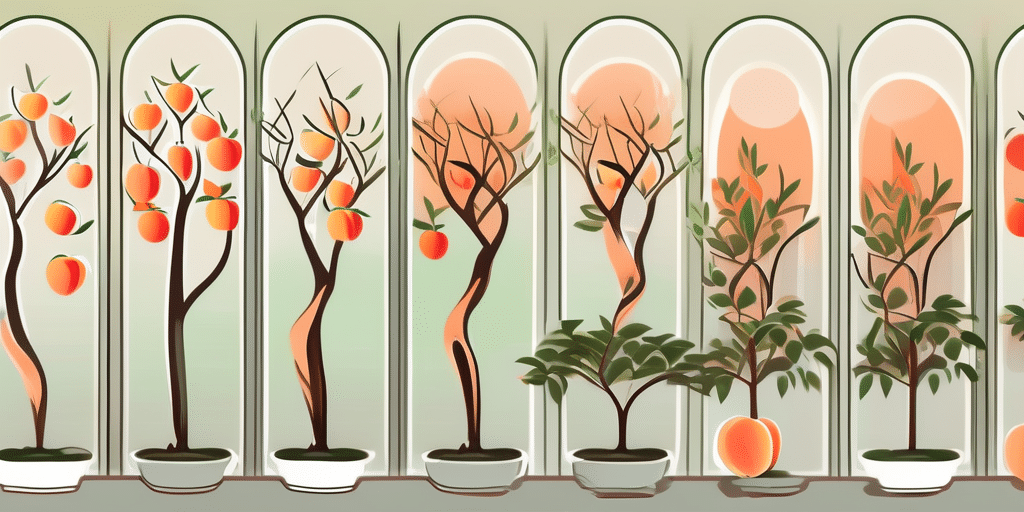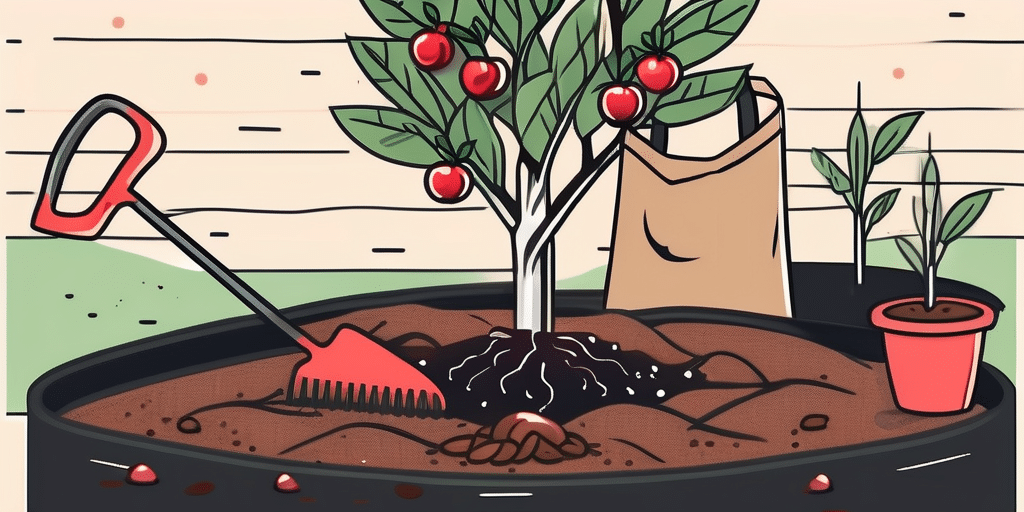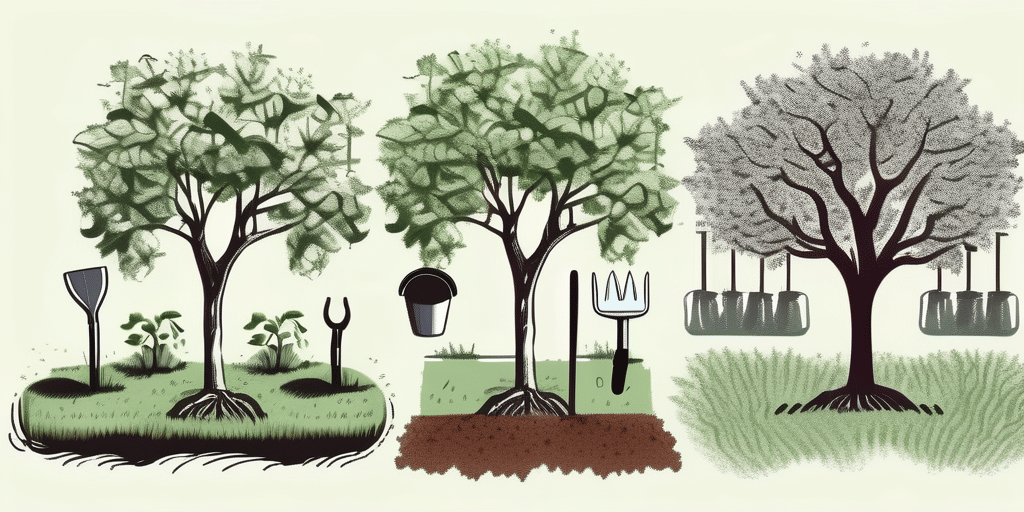If you’re interested in growing your own persimmon tree, you’ve come to the right place! In this ultimate guide, we’ll take you through everything you need to know about understanding, planting, and caring for your persimmon tree. By the end, you’ll be well-equipped to grow a healthy and productive tree that will provide you with delicious persimmons for years to come.
Understanding the Persimmon Tree
Before diving into the planting process, it’s important to have a good understanding of the persimmon tree. Let’s start by exploring the different types of persimmon trees:
Types of Persimmon Trees
There are two main types of persimmon trees: the American persimmon (Diospyros virginiana) and the Asian persimmon (Diospyros kaki). The American persimmon is native to the Eastern United States and is known for its strong, sweet flavor. On the other hand, the Asian persimmon originated in China and Japan and is typically larger and less astringent than the American variety.
Each type of persimmon tree has its own unique characteristics and growing requirements, so it’s essential to choose the right one for your specific needs and climate. Consult with local nurseries or agricultural extension offices to determine the best variety for your area.
The History and Origin of Persimmon Trees
Persimmon trees have a long and fascinating history. Native American tribes have been cultivating persimmons for centuries, using them both as a food source and for their medicinal properties. The Cherokee people, for example, believed that persimmon trees held spiritual significance and used them in various ceremonies.
Introduced to Europe in the 18th century, persimmon trees have since spread to various parts of the world, including North America and Asia. In Japan, the persimmon is considered a symbol of autumn and is often featured in traditional artwork and literature.
Today, persimmons are enjoyed by many people around the globe for their unique flavor and nutritional benefits. They are packed with vitamins A and C, as well as minerals like potassium and manganese. Additionally, persimmons contain antioxidants that help protect the body against oxidative stress and inflammation.
Whether you’re a fan of the American persimmon’s sweet taste or prefer the milder flavor of the Asian variety, incorporating persimmons into your diet can be a delicious and healthy choice. From pies and jams to salads and smoothies, there are countless ways to enjoy the versatile persimmon fruit.
Preparing for Planting
Now that you’re familiar with the basics of persimmon trees, let’s move on to preparing for the planting process. Here are a few key considerations to keep in mind:
Before diving into the planting process, it’s essential to understand the different varieties of persimmon trees available. There are two main types: astringent and non-astringent. Astringent persimmons are typically larger and need to ripen fully before consumption, while non-astringent varieties can be eaten while still firm. Consider your preference and purpose for planting the tree when selecting the variety that best suits your needs.
Choosing the Right Location
Persimmon trees thrive in areas with full sun exposure, preferably for at least six hours a day. Select a location in your garden that receives ample sunlight and has well-draining soil. Avoid planting near structures or trees that may shade the persimmon tree and inhibit its growth.
Furthermore, consider the proximity to other plants in your garden. Persimmon trees can benefit from being planted near other fruit trees like apple or pear trees, as they can share pollinators and create a more diverse ecosystem in your garden.
Soil Requirements for Persimmon Trees
Persimmon trees prefer slightly acidic to neutral soil with a pH between 6.0 and 7.5. Before planting, it’s advisable to test your soil’s pH level. If necessary, you can make adjustments by adding organic matter, such as compost or well-aged manure, to improve the soil’s fertility and drainage.
Additionally, consider the soil texture. Persimmon trees thrive in well-draining soil, so if your soil has a high clay content, you may need to amend it with sand or perlite to improve drainage and prevent waterlogging, which can be detrimental to the tree’s root system.
Planting the Persimmon Tree
Now that you’ve prepared the planting site, it’s time to dive into actually planting your persimmon tree. Follow these step-by-step instructions:
When to Plant Persimmon Trees
The ideal time to plant persimmon trees is in late winter or early spring, before the tree starts to break bud. This allows the roots to establish themselves before the tree’s energy is focused on foliage and fruit development.
Before you start planting your persimmon tree, it’s important to consider the variety you have chosen. There are two main types of persimmon trees: astringent and non-astringent. Astringent persimmons are high in tannins and must be fully ripe before eating, while non-astringent persimmons can be eaten when still firm. Make sure you know which type you have to properly care for your tree.
- Start by digging a hole that is twice as wide and just as deep as the root ball of the tree.
- Gently place the root ball in the hole, ensuring that the base of the tree is level with or slightly above the surrounding soil.
- Backfill the hole with soil, firming it gently around the roots to ensure good contact.
- Water the tree thoroughly to settle the soil and eliminate any air pockets.
- Apply a layer of mulch around the base of the tree, leaving a small space around the trunk to prevent moisture buildup and potential rot.
After planting your persimmon tree, it’s essential to provide proper care to help it thrive. Regular watering, especially during dry periods, is crucial for young trees. Fertilize your persimmon tree in early spring with a balanced fertilizer to support healthy growth. Pruning is also important to shape the tree and remove any dead or diseased branches. With the right care, your persimmon tree will reward you with delicious fruit for years to come.
Caring for Your Persimmon Tree
Now that your persimmon tree is in the ground, it’s time to provide the care it needs to thrive. Here are some essential tips:
When it comes to caring for your persimmon tree, there are additional considerations beyond just watering and feeding. Understanding the specific needs of your tree can help ensure its long-term health and productivity.
Watering and Feeding Your Tree
Young persimmon trees require regular watering, especially during hot and dry periods. Aim to provide around 1 inch of water per week, ensuring that the soil remains moist but not waterlogged. As the tree matures, it becomes more drought-tolerant, but it’s still important to monitor soil moisture levels.
Proper mulching around the base of the tree can also help retain soil moisture and regulate temperature. Organic mulches like wood chips or straw not only conserve water but also add nutrients to the soil as they break down over time.
Additionally, fertilizing your persimmon tree annually in early spring can promote healthy growth and fruit production. Opt for a balanced fertilizer, following the manufacturer’s instructions for application rates.
Pruning and Training Persimmon Trees
Pruning is an essential aspect of maintaining a healthy and productive persimmon tree. Here are some guidelines:
- Prune your persimmon tree during the dormant season, typically in late winter or early spring, before new growth begins.
- Remove any dead, damaged, or diseased branches.
- Thin out crowded areas of the tree to improve air circulation and sunlight penetration.
- Train your persimmon tree into a desired shape, such as a central leader or an open vase, depending on your preference.
Training your persimmon tree’s branches early on can help establish a strong framework for future growth. By guiding the growth of the tree in its formative years, you can encourage a balanced canopy and prevent structural issues down the line.
Troubleshooting Common Problems
While persimmon trees are generally hardy and disease-resistant, they can still face some challenges. Here are a couple of common issues and how to overcome them:
When it comes to pests and diseases, persimmon trees can encounter a variety of adversaries. Aphids, scales, and fruit flies are among the common pests that may target your tree. Regularly inspecting the foliage and fruit for signs of infestation is key to early detection. If you spot any unwanted visitors, consider employing organic insecticides or setting up sticky traps to manage the pest population effectively.
In addition to pests, persimmon trees can also fall victim to diseases like root rot or leaf spot. These ailments can hinder the tree’s growth and fruit production. To prevent such issues, it’s crucial to maintain proper soil drainage and ensure adequate air circulation around the tree. Should symptoms of disease manifest, seeking guidance from a local arborist or agricultural extension office can provide valuable insights into suitable treatment options.
Overcoming Weather Challenges
Extreme weather conditions, whether it be unexpected frost or prolonged heatwaves, can significantly impact the health and productivity of persimmon trees. To safeguard your tree against such weather-related adversities, consider implementing protective measures like frost blankets or shade cloth. These simple interventions can shield your tree from the harsh effects of extreme weather, allowing it to thrive despite the challenging conditions.
Furthermore, maintaining proper irrigation practices is essential, especially during periods of drought or excessive heat. Adequate watering can help persimmon trees withstand environmental stressors and promote healthy growth. Remember, successful persimmon cultivation demands patience, attentive care, and a willingness to adapt to the unique requirements of your tree. By adhering to these guidelines and remaining attuned to your tree’s needs, you can look forward to a rewarding harvest of delectable persimmons. Happy growing!
Join the How to Grow Everything Community
Ready to transform your green space into the garden of your dreams? Subscribe for free to How to Grow Everything and gain access to a wealth of personalized gardening advice tailored to your specific location, grow zone, and experience level. Dive into our extensive library of free gardening articles and enjoy special offers delivered straight to your inbox. No spam, just the best gardening tips and deals. From our family to yours, let us help you grow not just persimmons, but everything your heart desires in your garden. Happy gardening!





